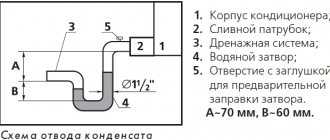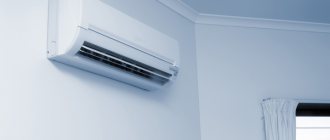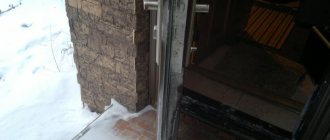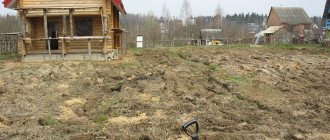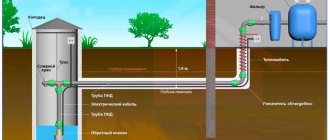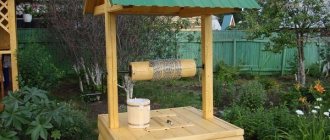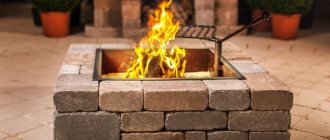The split system consists of internal and external parts. The process of operation of the device in cooling mode is accompanied by the release of liquid. Is condensation from the outdoor unit of the air conditioner not the most pleasant substance in this design? And bringing it into the premises is generally extremely undesirable, right?
There are no special technical difficulties in installing a drainage line to remove moisture. A special tube for collecting condensate is usually installed together with the outdoor unit of the split system. We will tell you about all the popular options for further arrangement of the drain.
Useful recommendations may be useful to you when monitoring contractors. Perhaps you will use our tips for making your own system for draining and recycling condensate.
Where does unnecessary liquid come from?
The air in the air conditioner is cooled by circulating refrigerant. The element of the flow pattern in which the temperature decreases is called the evaporator.
The device received this name because droplets of moisture, that is, “perspiration,” appear on its body during operation. The resulting liquid is the same condensate that requires removal from the split system unit.
Moisture is released from warm air at the moment of sudden cooling. One operating unit can accumulate up to 15-20 liters of liquid per day
Draining accumulated moisture is important for proper operation of the air conditioner. The climate control unit operates from the electrical network. As you know, water is a good electrical conductor. At high humidity there is a risk of a short circuit in the device circuit. Breakdown of expensive electrical equipment can be prevented by proper condensate drainage.
Why is air conditioner cleaning necessary?
Is regular cleaning of climate control equipment really necessary? Maybe this is just another “money scam” on the part of manufacturers and service companies? No, it's much more serious!
Devices that cool or heat air drive it through filtering devices installed in them, since it is unrealistic to completely get rid of dust in rooms. Accordingly, quite soon a large amount of dirt and dust collects in the filters.
Whether we like it or not, the air always contains suspended dust, to which fluff and pollen from plants can be added. All this accumulates in the air conditioner filters.
Therefore, if you do not periodically clean the air conditioner, the following problems will certainly arise:
- There will be a clear drop in the functionality of the device, that is, a significant decrease in efficiency due to the difficulty of air passing through the filters.
- If the air conditioner is not cleaned or is not cleaned regularly, the heat exchanger with the freon inside it will begin to overheat, which will increase the load on the compressor, and as a result, rapid wear of the device.
Dust mites - dust accumulations in uncleaned filters are literally teeming with such “dirty things”
- High humidity and dust deposits inside and outside the filters contribute to the active proliferation of dust mites and various bacteria. Among pathogenic microorganisms, the most dangerous is Legionella, which causes a severe lung disease – legionellosis (also called “Pittsburgh pneumonia”). Along with air flows passing through contaminated filters, spores of fungi and mold can spread throughout the premises, which can easily provoke allergic reactions, lead to asthmatic attacks and dermatitis.
- An unpleasant smell in the room is probably the most minor nuisance of all that is caused by air conditioner contamination.
It should be noted that air conditioners that are installed in multi-storey buildings on the highest floors are less susceptible to rapid clogging, since at high altitudes much less dust is concentrated than in the lower layers of air. But this does not mean that they will not have to be cleaned - there may simply be less dirt deposits.
Much more often it will be necessary to clean and disinfect devices installed in houses located near highways, in industrial areas of the city and in areas under construction, since the air there is most polluted.
Another negative phenomenon for climate control equipment is poplar and other plant fluff, which can literally clog air conditioner filters in a short time. Therefore, if the area where the house is located is planted with poplars or other trees (shrubs) with a similar form of flowering, then you need to monitor the climate control devices with special care.
Poplar fluff is the eternal “enemy” of any climate control equipment
The air conditioner, as a rule, begins to “declare” that it requires maintenance if it is not cleaned on time. So, such manifestations can be:
- Permanent or temporary noise or crackling noise when the device is turned on.
- Unpleasant smell of dampness or dampness.
- A clear decrease in the cooling capacity of the air conditioner.
- The device began to consume too much electricity with the same or even reduced output - this can be noticed by taking readings from the meter.
- While the air conditioner was running, the indoor unit began to leak.
How does drainage occur in practice?
A small sociological survey conducted among air conditioner users showed interesting statistics.
To the question where do you drain the condensate, the following answers were received:
- Just going outside – 68%;
- To the sewer by gravity - 16%;
- To a special drainage system – 8%;
- What kind of condensate is this? - 8%.
Let us explain the essence of liquid discharge for the unenlightened last category of owners of split systems. For those who do not know where the condensate formed in the air conditioner goes, it is useful to read the instructions for the device. It gives clear instructions for installing the drain outlet from the air conditioner unit.
The problem requires special attention in large private houses with several air conditioners in different rooms. An organized solution for condensate collection should be made at the design stage of the climate system
You should remember the peculiarities of climate control equipment that produces liquid not only during design and installation. It is also necessary to monitor the process of moisture removal when operating the air conditioner.
Saint Petersburg
INN: 7801190998 Legal address: 191124, St. Petersburg, st. Stavropolskaya, 10, lit. A
Checkpoint: 784201001 Actual address: 191124, St. Petersburg, st. Stavropolskaya, 10, lit. A. (address for receiving correspondence)
Checkpoint: 772143001 Branch of Promoborudovanie-SIS LLC in Moscow 109428, Moscow, Ryazansky Prospekt, 16, building 4
account: 40702810555160162144 to the North-West Bank of OJSC Sberbank of Russia, St. Petersburg
BIC 044030653 c/s: 30101810500000000653
OKPO 56325292 OKONKH 66000, 95130, 14112, 61124 OKVED 51.70, 51.53.21, 51.54.2
General Director Ivanova Tatyana Yurievna
All rights reserved LLC Promoborudovanie-SIS 2001-2016. Any copying of materials from the PROMSIS.SPB.RU website is possible only with the written permission of the company.
What is condensate?
The risk of harm to health from improper removal of evaporated moisture is much more dangerous than the threat of a split system breakdown. Although, in terms of its chemical composition, condensate is just ordinary water. But the fact is that pathogenic microbes accumulate in stagnant warm moisture.
The consequences of not draining condensate can be:
- unpleasant musty smell from the air conditioner;
- reproduction of Legionella pathogens;
- formation of various forms of mold.
It is a mistake to consider air conditioning to be the main cause of severe Legionnaires' disease. A dangerous microorganism lives in the soil, swimming pools, and decorative fountains. Wherever there is stagnant water, even in medical physiotherapy equipment, there is a risk of encountering Legionella.
Removing excess moisture from the split system is necessary for the health of your family. Constantly draining condensate will not give a chance for water stagnation to develop
The drainage system is designed to drain excess moisture. Correctly performed condensate drainage and timely maintenance make air conditioning equipment completely safe.
1. General diagram and rules for installing an air conditioner consisting of a split system
In order for an air conditioner to fully live up to the expectations placed on it, three main conditions must be met:
— choose a model according to the volume of the room;
— install the air conditioner correctly;
— operate it in accordance with all rules, taking preventive measures in a timely manner.
Let's consider the rules for installing an air conditioner, namely, split-system type air conditioners will be considered. As practice shows, the cause of more than half of the cases of unsatisfactory operation of the air conditioning system or its premature failure is incorrect installation. Improper installation of an air conditioner can minimize the service life of even a very high-quality and expensive device.
What methods are there for discharging water?
The cheapest option is to remove the by-product by gravity. But even in this fundamental implementation there are variations. They are located at the point where condensate is received.
The main methods of draining liquid:
- Just take the drainage pipe outside and leave it on the wall with condensation dripping. This standard technique is used in most installed split systems.
- Connect a long drainage hose to the outlet and collect the condensate in a container. In hot weather, you will have to monitor the filling of this drain tank, which is not entirely convenient.
- Drain pipes can be routed into a nearby sewer pipe or sink. Such a gravity system requires strict adherence to the slope of the highway during installation.
- Install a circuit for forced removal of moisture into the sewer using a pump. A pump is used at a considerable distance from the air conditioner to the point where condensate is released.
Air conditioning is not the cheapest of modern technological advances. Therefore, you should not skimp on the correct design and installation of a waste moisture drainage system.
Collecting condensate in a plastic bottle does not require material costs. The main thing is to drain the accumulated liquid into the sewer in a timely manner.
In any case, drainage must be done correctly from the very beginning of installation of the split system. Whatever option you choose for removing condensed moisture.
Wire cleaning
Another way to clean the drainage hole in the refrigerator is to completely defrost the refrigerator and dry it for 7-10 hours.
Next, you need to use a thin wire to remove the blockage in the tube, being careful not to damage the tube under any circumstances. Cleaning the drainage must be done on both sides at once, after which the hole is washed with warm water.
Important: the wire should not have sharp ends, so before work its edges should be lightly sanded with fine-grain sandpaper. In refrigerators with the No Frost system, the cleaning brush can be located directly in the drainage hole, so the tube can be cleaned without the use of additional products
In refrigerators with the No Frost system, the cleaning brush can be located directly in the drainage hole, so the tube can be cleaned without the use of additional products.
Requirements for installation of drainage pipes
Air conditioner manufacturers do not recommend using electrical wiring corrugations or garden hoses in condensate drain lines. The route of the gravity condensate drainage system should not have bends or sharp turns.
Special smooth and corrugated pipes for condensate drainage have the required strength. They are made of polyethylene, polystyrene, and metal-plastic.
The drainage line parameters are as follows:
- Horizontal sections have a slope of about 3%, on turns the maximum permissible angle is up to 45o;
- The standard inner diameter of pipes is usually 16 mm, hoses cannot be inserted into each other;
- Tight connection of the hose to the split system unit is ensured by fitting adapters.
At the bottom of the housing of the external unit of the air conditioner there is a special hole for connecting a flexible drain pipe.
Errors when installing the drainage line are costly for the owner of the air conditioner. Improperly equipped drainage from a split system can cause flooding of the basement and lower floors of the house
To lay connecting cables and a condensate drain hose between the outdoor and indoor units of the split system, a hole is punched in the wall. It must be made with a slope towards the street. Even with a scheme with forced removal of liquid. After all, the pump may fail and for some time the moisture will be removed by gravity.
Installation of the outdoor unit
The choice of location for installing an outdoor unit must be taken extremely seriously - not only the efficiency of the device and its safety, but also the comfort of both the owners and residents of neighboring apartments will depend on the result.
The outdoor unit is attached to the wall of the building or on the side of the balcony. It is allowed to install the block inside the balcony, but only if it is not glazed. The unit must not be installed on the ground unless the equipment is properly supported.
The surface on which the outdoor unit will be mounted must be rigid, durable and able to withstand the weight of the equipment (and the unit can weigh several tens of kilograms). The outdoor unit is mounted on brackets, which are sometimes supplemented with vibration-damping gaskets, although this is not a mandatory step.
It is important that the outdoor unit is level and positioned strictly horizontally, as distortions can lead to malfunctions. The block body is installed so that there is a gap of empty space between it and the wall. There should be no wall protrusions or other obstacles near the unit that interfere with air exchange
Poor air circulation reduces air conditioner performance
There should be no wall protrusions or other obstacles near the unit that interfere with air exchange. Poor air circulation reduces the performance of the air conditioner.
The unit should not be located in close proximity to the windows of neighboring apartments - the noise it produces and warm air currents can disturb residents, and this will become a reason for complaints from the housing inspectorate. If you plan to remove the drainage channel through the outdoor unit, then you need to mount it so that condensation does not drip onto the walls, window sills and passers-by below.
The simplest and most economical type of installation is to install the outdoor unit under the window. However, it is not always successful. Thus, due to the close location of the outdoor unit to the window, noise and vibrations arising from the operation of the device can be felt indoors. Therefore, many owners choose to install the outdoor unit on blank walls, away from windows. In this case, the wall itself will become a reliable protection against noise. But installing the block on it will also cost more, since it will have to be hung, at best, using a stepladder (if we are talking about the lower floors of the house), and at worst, by resorting to the services of industrial climbers.
Unlike most types of household appliances, an air conditioner requires servicing. Not only the indoor unit, but also the outdoor unit is subject to periodic inspection and cleaning. Therefore, the easy availability of the block for craftsmen is a definite plus. But it’s not always possible to figure it out in such a way that it’s convenient to get to the block, and at the same time it doesn’t interfere with anyone. It is usually easier to inspect outdoor units mounted under a window (some manufacturers develop units with an easily removable top cover for this purpose), on the ground floor, on a balcony. If the block hangs at a distance from the windows or even on a blank wall, then the services of the same industrial climbers will be needed for inspection.
Outdoor units are designed taking into account the fact that they can be placed outdoors, but it is better to protect them from exposure to direct sunlight and precipitation. For these purposes, you can install a canopy on top of the outdoor unit - it will protect the equipment from the sun, water, snow, as well as from falling icicles and ice when cleaning the roof.
Link on topic: Climate control equipment (humidifiers, split systems, air conditioners) in questions and answers
Discharge into the sewer system
The optimal solution is to drain the condensate into the sewer. The problem with this type of drainage is that air-conditioned residences usually do not have a drainage section.
The following article, which we recommend reading, will tell you what to do if condensation from the air conditioning unit flows into the room being treated.
The solution is one of the following options:
- Laying a drainage pipe observing slopes to a sewerage system in another room.
- Installation of a sewer pipe to the room in which the air conditioning unit is installed.
Choose a condensate drainage method that is acceptable to you. As a rule, labor intensity and cost of materials are lower in the first case.
Diagram of the drainage line inside the house
The outdoor unit does not produce condensate in cooling mode. Water dripping on the heads of passers-by in the hot summer from the air conditioner is collected in the indoor module. And then it is removed from a special storage bath through a drainage pipe to the outside.
But it is not at all necessary to remove the liquid to the external module of the system. The condensate collected in the room can be directed from the air conditioner into the sewer system to the nearest riser indicated in the piping diagram inside the house. The shorter the length of the drainage system section between the internal module of the split system and the sewer, the easier it will be to maintain and repair the main line.
During design and installation, a large number of turns of the condensate drain line should be avoided. It is better to make a hole in the wall when laying a line into an adjacent room
Connecting the condensate drain line to the sewer system requires knowledge and experience. If you are going to do such work yourself, consult with craftsmen who have practical experience in this field.
Installing a condensate siphon
A water seal serves as protection against the penetration of unpleasant odors from the sewer into the room. This function is performed by a conventional sewer siphon. The device is mounted at the junction of sewer and drainage pipes.
Moisture from the air conditioner first accumulates in the siphon. At a certain level of the device there is a shutter that releases liquid into the sewer. Siphons are equipped with a protective valve that protects against the penetration of odors.
According to installation methods, siphons are classified into:
- closed built into the wall;
- external open design;
Structurally, they are conventional with a water seal, ball with a rubber locking element, dry with a jet break and without this function, etc.
Built-in closed siphons have different depth dimensions. To install them in the wall, you should select a model that corresponds to specific dimensions.
External siphons made of transparent plastic are convenient, allowing you to monitor their overflow and contamination
The efficiency of a device is characterized by its throughput. Different models of siphons differ in the type of thread. Please consider this point when purchasing equipment.
Beginning of work
The first stage is to design the placement of the air conditioning system. For example, you should determine where both air conditioning units will be located. It is a well-known fact that a split system consists of two blocks, one of which is located indoors, and the other outside, on the outside of the building. They are called internal and external blocks, respectively. At the same time, it is also a prerequisite to take into account the fact that they must be connected by a special route, presented in the form of copper tubes.
The initial steps also involve studying the documentation that came with your air conditioning system. It should also say what can be done and what cannot be allowed. In addition, it sets out the characteristics of the maximum possible length of the highway connecting both blocks. The work itself is performed as follows:
- So, the work itself begins with the installation of the external component. As for the capacitor, this element should be placed outside the wall. Particularly lucky in this case were the residents of the lower floor and the lucky owners of an unglazed balcony. This is explained by the ease of installation of the external unit of the split system, which can be done with your own hands. In all other situations, the help of high-altitude installers will be required.
- The external part of the system is secured to the wall using brackets. They are fastened with anchor bolts. If you are thinking about the question of how to properly install a split system, do not forget to position the external component of the split system perfectly level. Maximum reliability must also be ensured. This can be explained by the fact that the capacitor will be exposed to all sorts of natural influences for many years.
- Further actions are related to such a stage as installation of the indoor unit. To achieve this goal competently and correctly, you will also have to try. We take a building level and, using dowels, install a special strip into the wall on which the evaporator will be mounted. It is also worth noting that the corresponding strip in the vast majority of cases is included in the delivery package of the air conditioning system. As you can see, the rules for installing the outdoor unit are somewhat different.
Why do you need to drain into the sewer?
Connecting the drainage system with the sewer system is the most expensive option for removing condensate from a split system. But experts recommend choosing this method, despite the costs. Because he is the most correct in all respects.
The feasibility of a complex option
The first air conditioners were installed without much thought for the environment. But today environmental issues come to the fore in the technical development of society.
Expensive climate control equipment is purchased for a long service life. Your caring care will prolong his life
The health of humans and their smaller pet friends requires care. Illnesses take away energy and money for medicine. Therefore, the most expensive method of diverting the drainage line into the sewer will pay off over time due to savings on treatment.
Clean air without harmful vapors from dripping condensation is useful both in a country house and in local areas in multi-storey urban areas.
What do the rules dictate?
Discharging liquid into the sewer is only recommended, but is not prohibited by the instructions for climate control equipment. It’s just that this method is the most gentle for proper long-term operation of the device. It eliminates the dangerous consequences of the accumulation of large amounts of moisture on the air conditioner evaporator.
Constantly slipping statements about the legal requirements to install a condensate drain only in the sewer system are unfounded. Those interested can verify this by reviewing the judicial practice on claims against owners of air conditioners with gravity street condensate drains. The courts refuse to satisfy such claims as they are not justified by legislative norms.
There are local bans on the release of condensate into the atmosphere as part of decisions made by housing developments. We will not discuss the legality of such documents. As they say, the collective farm is a voluntary matter.
Building codes require condensate to be discharged into the sewer system. But compliance with SNiPs is mandatory only for new premium-class residential buildings put into operation with an installed air conditioning system
And yet there is one general prohibition that applies to any condensate drainage systems. Do not drain moisture from the air conditioner into a storm drain. This is dangerous for the equipment. Due to increased pressure during rain, water may flood the air conditioner through the drain pipe.
Disadvantages of gravity drainage to the street
A simple accessible method is used for reasons of saving time on installation and money on paying for the services of craftsmen. However, this method of removing condensate has a number of unpleasant nuances.
Water flowing out of the drain pipe:
- pollutes the facade, windows, and sometimes gets on passers-by;
- disrupts the silence of the night, spreads dangerous germs;
- slowly but surely destroys the structural elements of the building.
The sight of dirty puddles under the module does not cause aesthetic delight. The sound of drops at night may not bother you at all. But it is unknown how your sensitive neighbors in an apartment building or townhouse will react to noise.
In a private house, a hose with dripping water hanging on the wall spoils the appearance with its sloppiness. Steam particles carry organic harmful components of condensate throughout the local area
The water itself, formed from collecting condensate, is an undesirable product and requires disposal. From the point of view of hygiene, ethics, and the safety of people and pets, it is best to dispose of such waste liquid into the sewer system.
Design features
As an example, you can use split systems.
Their outdoor unit includes several main components, including a compressor, control board, valve, fan, radiator, freon system filter, protective cover and fitting connections. With the help of a compressor, freon is compressed and its movement along the refrigeration circuit is maintained. The basis can be a piston or a spiral. Models with a piston have a lower price, but are not reliable enough. This is especially true in the cold season, when there is a drop in temperature outside. A four-way valve is provided in those systems that operate on both cold and heat.
Inverter outdoor units require a control board. In other cases, the electronics system is located internally to prevent damage due to changes in temperature and humidity levels.
The fan serves to cool the condenser in a timely manner. If we are talking about budget models, it will have one rotation speed, but in more expensive ones it depends on what the outside air temperature is. Most often, fans have 2-3 speeds, which are regulated quite smoothly.
As for the radiator, it is due to it that cooling and condensation of freon occurs. The freon filter provides protection from copper chips and other elements that clog the air conditioner during installation and operation. However, if errors were made during the installation process, then a significant amount of dirt can get inside, which even this system cannot cope with.
The protective cover hides the terminal block, and in some cases, the connections on the fittings, to which, in turn, the connectors of both air conditioner units are connected.
Causes of Drain Line Failure
The consequence of improper installation or the use of low-quality materials is condensate leakage from the drainage system. In such cases, you have to pay for additional work by specialists to eliminate defects.
The causes of the malfunction are the following:
- The hole in the wall for the drainage pipe and other connecting conductors between the outdoor and indoor units is drilled parallel to the floor, and not with a slope towards the street;
- Weak insulation or its complete absence on the freon tube causes moisture to collect on its surface and condensate to drain outside the drainage system;
- Kinks and damage to the laid drainage pipe block the path to the free or forced flow of moisture, causing overflow and leaks from the condensate drainage line.
Due to poor-quality rolling, a freon leak may occur. Then the heat exchanger freezes and moisture drains from it when the air conditioner is turned off.
The split system should not be used to heat a room when the outside temperature is below zero. With the exception of air conditioners equipped with heated drain pipe and compressor
In winter, when the air conditioner is turned on for heating, moisture from the hot air forms on the external module of the split system. The drainage tube freezes at low temperatures, and a leak appears on the entire surface of the outdoor unit.
The reasons listed are not exhaustive. Breakdowns of the drainage system and condensate leaks can also occur due to improper care and contamination of individual parts of the split system. Our recommended article will introduce you to the rules and specifics of cleaning climate control equipment.
Automatic cleaning of climate control equipment
Modern models of split systems are equipped with options designed to make the owner’s life easier. Their work is aimed at carrying out cleaning without interruption in work. In this case, air masses move through the internal systems and heat exchanger at idle speed. Newer models are equipped with ion air purification systems. Activated oxygen ions form complexes with dust particles, transferring charge to them. “Charged” particles are caught by a special trap. Combining the two systems significantly increases the cleaning potential of the air conditioner.
When installing a pollution sensor, the device independently regulates the activity of filtration systems based on air quality. The listed innovations make it easier to care for climate control equipment. But the device will not be able to wash the filters on its own, so you will still have to clean the air conditioner.
Conclusions and useful video on the topic
Correct installation of a siphon for the drainage system for discharging condensate into the sewer system:
How not to drain condensate into the sewer system, analysis of errors in installing an air conditioner drainage system:
If the system for draining moisture from your split system does not suit those around you, think about changing the way you remove unnecessary liquid. You can independently drain condensate into the sewer system from the air conditioner drainage system or have specialists install it.
Have you already completed this task and are ready to share your practice? Tell us about the important points missed in this review of the problem of condensate drainage? We look forward to publishing your photos, questions, comments, and useful tips.
Flaring of copper tubes
We move on to the stage of preparing the tubes.
Mistake No. 5 You can cut them only with a special pipe cutter, no hacksaws or grinders!
When making a cut, it is necessary to hold the end of the copper pipe strictly downward in order to prevent any chips from getting inside.
The ends are processed with a rimmer.
Use the rimmer carefully to avoid scratching the skirt. The quality of rolling is one of the most important points in installing an air conditioner.
https://youtube.com/watch?v=lW7wjQICPOM%3F
Error No. 6 Flaring is done with a special tool with an eccentric. Don't forget to put the connecting nut on the tube before this step!
The width of the flare should be such that the connection eventually fits freely and unhindered into the nut.
The height of installation of the tube in the rolling clamp is strictly regulated.
The simplest and most proven old-fashioned way to determine the quality of rolling, at least at the initial stage, is to see your reflection in the “skirt”.
Flaring of the pipes of the outdoor unit will have to be done outdoors on weight. Otherwise, the line simply will not fit through the hole.
Error No. 7 Please note - if the installation does not take place on a hot, warm day, then when bringing copper pipes home from the street, close their ends and be sure to wait time for the copper to reach room temperature.
If you bring them in cold and open, then due to the dew point effect, condensation will form inside the tube, which, on a poorly evacuated air conditioner, can lead to dire consequences.
Overview of siphon for collecting condensate from air conditioning systems
Description of the siphon
Built-in siphon for collecting condensate from air conditioning systems, vertical, with a 93mm high water seal and a mechanical odor-locking device that does not allow odor from the sewer when the water dries in the water seal, with a decorative cover. Inlet pipe Ø32mm for soldering PP pipes with an elastic adapter for connecting pipes Ø16, Ø20, Ø25mm. Outlet pipe Ø16, Ø20, Ø32mm.
Siphon equipment
- The lower part of the mounting box is 166*120*42mm (H*W*D) made of UPS.
- The upper part of the mounting box is 176*130*48mm (H*W*D) made of UPS, which has a decorative cover 176x130mm cut to the level of the plaster with spring clips for fastening to the lower mounting box.
- A collapsible siphon with a water seal and a mechanical odor-locking device - a ball, made of PP.
Technical characteristics of the siphon
- Connecting dimensions: Input Ø16, Ø20, Ø25, Ø32mm, Output Ø16, Ø20, Ø32mm.
- Weight: 0.35 kg.
- Throughput: 0.09 l/s.
- Service life: at least 50 years.
Self-production
Due to the considerable, in modern times, cost, from 1.5 to 2 thousand rubles. Many air conditioner owners are wondering: how to make a siphon for an air conditioner with your own hands?
Our company’s specialists answer such questions unequivocally: Making a device with a check valve is quite difficult without special equipment.
At home, you can make an ordinary U-shaped structure from a plumbing pipe, but after some time of inactivity of your climate control equipment, the water from the water seal elbow will evaporate and your apartment will be filled with the “wonderful aromas” of the sewer. In addition, a drainage unit that can be made from improvised means will be quite bulky and difficulties will certainly arise during its installation.
